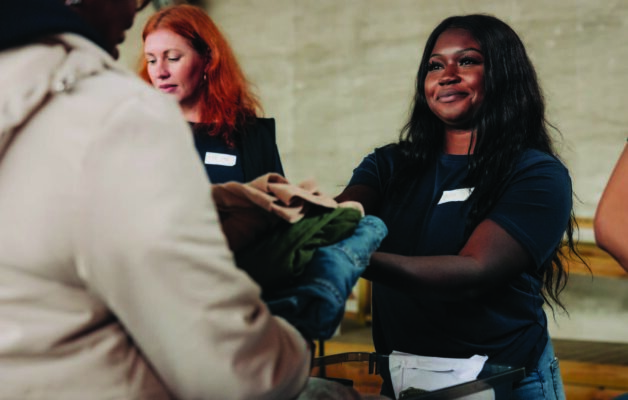VOLUNTEERING IS A GIFT TO OTHERS—AND
OURSELVES
You won’t just find a passion, you’ll find yourself.
Our life experiences, our talents, the people we care about, the causes that impassion us — they form the core of who we are. We all have so much to offer others, so much to give. It’s important for us to carve out some time in our busy lives to volunteer — our communities we cherish rely on it. And when we give back, we find out we end up giving ourselves a gift too, one that can reinvigorate and perpetuate us getting back out there again and again.
Volunteering connects you to others, enabling you to make friends with a shared interest while increasing your social and relationship skills. In fact, it’s great for your mind and body, effectively counteracting the stress and anxiety we all experience in daily life, increasing self-confidence, providing a sense of purpose, and fostering new perspectives— all while keeping you physically active. (1)
How to get started
There are three big things you want to do to prepare for volunteering and jumpstart this rewarding journey. The first is taking the time to self-reflect and fully understand your core values. This will help you align them to an experience that will keep inspiring you while helping the organization ensure they have the right people to fulfill their mission.
The next step is to brainstorm ideas. Family, friends, and coworkers can be a great resource to get you going. The people we are closest to are often able to provide a unique and invaluable perspective on what we’d enjoy the most. Make a list of what you’re
passionate about and then whittle it down to three to five things. This will further help you be intentional about choosing how you spend your time giving back, and chances are you’ll find something that will feel right and energize you for a longer period. (2)
Now you’re ready to dive a little deeper and do some research. Rather than starting off by scouring the internet for opportunities related to the top things on your list, target your research strategically. Use phrases that combine your core values and the top things on your list. Try including particular skills you have, your age group, and keywords reflective of the level of commitment realistic for your schedule.
Applying for volunteer opportunities
Some people are surprised that volunteering requires an application process. But nonprofits might be the most organized and strategic organizations you ever come across—because they have to be. They have small budgets and a ton to coordinate for every project in order to accomplish their goals.
These are the key steps you need to follow in the application process and beyond: (3)
Identify the skills and knowledge you can offer: Nonprofits often require you to have certain skills for specific opportunities. But most also have entry-level opportunities to train you on the basics.
Create a volunteer resume: List your skills, interests, and previous volunteer experiences. This allows the organization to quickly match you with the right opportunity.
Use volunteer websites: There are a lot of these out there and they will often help you find the right experience much faster
than you would on your own.
Get all the details: Before applying for a volunteer position, ensure that you know all of the details. Learn about the tasks you’ll complete, the level of commitment needed, and any required training.
Apply for the position: While these applications are usually not as stringent as those for a job, you should still treat the application as if it’s for a professional position. Take time to ensure proper grammar and spelling, and provide references if asked for them. You may also have to interview.
Complete any required training: Most training will be minimal, but some organizations require you to hold a certification or complete a training course before you can begin volunteering.
Start with a limited commitment: When you first start, plan your schedule only a month or two into the future. See if you enjoy the position and organization before you make a full commitment.
Regularly assess your experience: Check in with yourself every few months to make sure you still enjoy the volunteer position. You can always speak with your coordinator about other roles in their organization.
Give back and you’ll be amazed at what you get back
Volunteering is a great way to give back to the communities that give us so much. It’s also a great way to stay active, learn and grow. If you follow your passion, you’ll always get back even more than you put into it. Mind, body, heart, and soul — every part
of us benefits when we give freely to the causes that mean so much to us. There’s no shortage of causes and organizations, so get
out there and explore.
Thanks for checking out the blog.
Gregory Armstrong , CFP®
Sources
(1) HelpGuide.org: Volunteering and its Surprising Benefits
(2) Second Wind Movement: 7 Steps to Finding the Right Volunteer Opportunity
(3) Indeed: How To Volunteer: 13 Steps To Start Volunteering in Your Community
This material is for general information only and is not intended to provide specific advice or recommendations for any individual. There is no assurance that the views or strategies discussed are suitable for all investors or will yield positive outcomes. CDs are FDIC Insured to specific limits and offer a fixed rate of return if held to maturity, whereas investing in securities is subject to market risk including loss of principal.
This material was prepared by LPL Financial.
Securities and advisory services offered through LPL Financial (LPL), a registered investment advisor and broker-dealer (member FINRA/SIPC).
Insurance products are offered through LPL or its licensed affiliates. To the extent you are receiving investment advice from a separately registered independent investment advisor that is not an LPL Financial affiliate, please note LPL Financial makes no representation with respect to such entity.
Securities and insurance offered through LPL or its affiliates are: 









